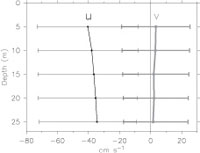
Fig. 1. The mean zonal (black) and meridional (gray) currents (cm s−1) at 2°N, 140°W with ±1 standard deviation indicated at 5, 10, 15, 20, and 25 m, computed for the period 24 May–7 Oct 2004.
Fig. 2. Vectors of the 2°N, 140°W mean wind (blue) and currents relative to 25 m (black) with their geostrophic (green) and ageostrophic (brown) components, as (a) observed for the period 24 May–7 Oct 2004 and as simulated by the (b) classical, (c) frontal, and (d) generalized Ekman models. The wind shown in (a) is the vector wind speed and in (b)−(d) is the wind stress vector. The surface geostrophic stress (τp = ρ0ν ∂ug/∂z) and effective wind stress (τeff = τ0 − τp) are also shown in (c). The magnitudes of the wind and relative currents are indicated by the circles. Units for the relative currents are cm s−1, m s−1 for wind speed, and 10−2 N m−2 for wind stress. Currents at 5, 10, 15, and 20 m, relative to 25 m, can be distinguished by their decreasing amplitude. Standard errors are indicated by the ellipses on the arrow heads. The vectors in (a) are superimposed upon the mean TMI SST field.
Fig. 3. Five-day-averaged time series of the 2°N, 140°W winds (blue vectors), temperature (color shading), and (a) currents (black vectors) and (b) currents relative to 20 m (black vectors) and surface geostrophic current relative to 20 m (green vectors). The vector scale for the currents, winds, and relative currents is shown at the bottom.
Fig. 4. Mean tropical instability wave composite (1 Nov 2004–28 Feb 2005) of (a) anomalous temperature (color), anomalous velocity (black vectors), and wind (blue vectors); (b) temperature relative to 28.3 m (color) and velocity relative to 20 m (black vectors); (c) as in (b) but for geostrophic currents relative to 20 m (green vectors); and (d) as in (b) but for ageostrophic currents relative to 20 m (brown vectors). The vector scale is shown at bottom.
Fig. 5. Mean diurnal composite (24 May 2004–7 Oct 2004) of wind (blue vectors), temperature (color shading), and currents relative to 25 m (black vectors). The vector scale is shown at the bottom.
Fig. 6. Mean diurnal composite of (a) buoyancy frequency N2, (b) shear squared, and (c) Richardson number. The units in (a) and (b) are 10−4 s−1; Ri in (c) is nondimensional.
Fig. 7. Mean profiles of N2 (short dashed), shear squared (long dashed), and Ri (solid) averaged over the diurnal composite shown in Fig. 6.
Return to Abstract
Go to References